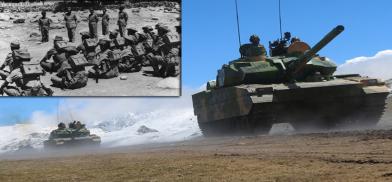India of 2020 is different from the India of 1962
In the current scenario, although India being a peaceful country does not want war with anyone, especially with China, India has developed infrastructure at the borders, strengthened its defence forces and has strategic relations with several countries, writes Jai Kumar Verma for South Asia Monitor

China is under international pressure because of several reasons, including the spread of coronavirus. Australian Prime Minister Scott Morrison has demanded an investigation about the origin of the outbreak of COVID-19 pandemic which infected more than five million people in the world. US President Donald Trump also charged China that it could have done more to avert the spread of the disease. The tension between the US and China is rising on trade issues, problems in the South China Sea are also enhancing. Besides China, Vietnam, Philippines, Taiwan, Malaysia and Brunei all have competing claims in the area.
Taiwan President Tsai Ing-wen is issuing anti-China statements and France has rejected Chinese warning and mentioned that it will sell arms to Taiwan as it is part of existing agreements and China should concentrate on fighting COVID-19. The situation in Hong Kong is still volatile and China is not able to quell the anti-Beijing demonstrations and agitations.
Besides international pressure, Chinese President Xi Jinping is also facing internal dissension and opposition from several quarters. The opposition, which started from academic circles, soon spread among the political and business class. People are opposed to March 2018 resolution which permitted Xi and others to continue on their posts indefinitely. People feel it is the beginning of ‘one-man rule’, though it is not said so openly. People are also critical of mishandling of spread of coronavirus and the rise of unemployment in the country.
President Xi was also unhappy by India’s moves. Firstly, when two important members of Bharatiya Janata Party (BJP) parliamentarians attended the virtual swearing-in ceremony of Taiwan’s President along with 92 celebrities, including US Secretary of State Mike Pompeo, on May 24, 2020. Again, on June 2, when Trump called Prime Minister Narendra Modi, not only did he invite Modi to attend the G-7 summit but also discussed the standoff with China at the Galwan Valey. Modi’s virtual bilateral meeting with Australian PM Morrison on June 4 also didn’t go down well with China. At present relations between China and Australia are tense as the latter is questioning the spread of the coronavirus and wants a global impartial probe into its origin.
China unhappy at India's border infrastructure
However, the biggest reason for Chinese invasion was that India, which had for decades not developed infrastructure on the border areas, was now building strategic roads, bridges, airstrips etc. China which had already developed infrastructure was resisting infrastructure development by India. Recently Border Road Organisation (BRO) had constructed 255 km long Darbuk-Shyok-DBO Road near the Line of Actual Control (LAC).
In view of the above, People’s Liberation Army (PLA) trespassed at Pangong Lake, Galwan Nala and Sirijap Range areas, which had remained peaceful in the past. The PLA impinged the LAC, obstructed Indian patrol, and destroyed the bridges on Galwan river. There were border skirmishes as well as physical clashes on May 5, 6 and 11. However, on the night of June 15, Colonel Santosh Babu, Commanding Officer (CO) of 16 Bihar Regiment, went to check whether Chinese were returning to their original positions as per the agreement. The Chinese attacked the CO and his party with roads, sticks fitted with barbed wire at Galwan valley. Indian forces retaliated and in the violent clash, 20 Indian soldiers including the CO were killed but the valiant jawans of 16 Bihar killed an unspecified number of Chinese soldiers including their CO.
The second round of Lt. General-level talks were held at Moldo, in Chinese territory, on June 22 in which 14 Corps Commander Lt. Gen Harinder Singh demanded immediate withdrawal of Chinese troops to the position of May 2. Although the Chinese have not entered the Indian territory but occupied the area in between where even the patrolling is also not done. India presses that no army should occupy the vacant area. The promises the Chinese made in the previous meeting held on May 6 was not fulfilled by the PLA. China is also trying to occupy full Pangong Lake although at present about 45 km are with India.
India prepared for long standoff
The Indian government has given a free hand to Indian defence forces and the army has already sent few thousand soldiers to forward locations from reserve areas and fresh troops are sent to reserve areas so that they can be acclimatized. The Indian Air Force has also deputed Sukhoi 30 MKI, Jaguar, Mirage 2000 aircraft as well as Apache attack helicopters. India is prepared for a long standoff as it appears that both sides do not want war.
Defence Minister Rajnath Singh went to Moscow on a three-day visit on June 22. Though the ostensible reason was to attend the 75th Victory Day Parade, the 75th anniversary of the Soviet victory over Nazi Germany in the Second World War, the real purpose of the visit was to ensure the supply of spare parts of aircraft and other armaments. Russia is India’s biggest supplier of defence equipment, including the S-400 missile defence system.
China intruded and was using the same language it used when it attacked India in 1962 with the main objective of humiliating India and its first prime minister Jawaharlal Nehru. However, it failed to realise that India of 2020 is different from India of 1962. In 1962, the Indian Army was least prepared for a war with China to whom then India’s Defence Minister V. K. Krishna Menon thought of as a close friend. In the current scenario, although India being a peaceful country does not want war with anyone, especially with China, India has developed infrastructure at the borders, strengthened its defence forces and has strategic relations with several countries. According to an internal assessment, in case of war with China, the US, Japan, Australia and Vietnam will favour India, while Pakistan and North Korea will support China. Russia, Europe and the UK will remain neutral.
Now, China has realised the futility of invading India and it wants to retreat honourably. India also does not want war and will give China an opportunity for peaceful retrieval. Once both the forces retreat India must develop more infrastructure at borders as China is an expansionist country and an unpredictable neighbour.
(The writer is a New Delhi-based strategic analyst and member of USI and IDSA. The views expressed are personal. He can be contacted at jai_pushpa@hotmail.com)










Post a Comment